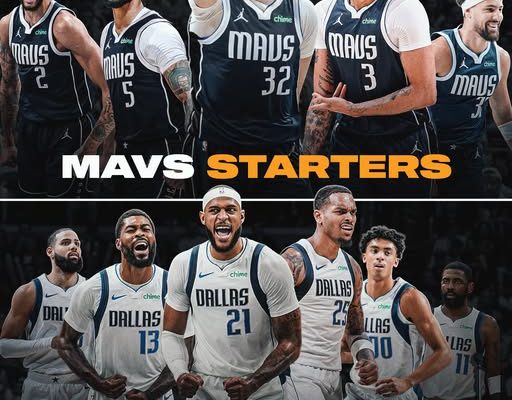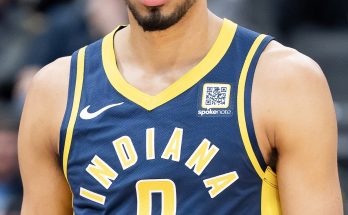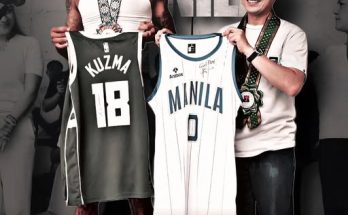The NBA has always been a league where eras are defined not just by individual brilliance but by the formation of rosters that strike a balance between seasoned veterans and emerging stars. As the 2026 season approaches, the Dallas Mavericks appear poised to usher in such an era, blending championship-tested veterans with an infusion of youthful talent. Their projected lineup featuring D’Angelo Russell, Klay Thompson, Cooper Flagg, Anthony Davis, and Dereck Lively II has ignited discussions around the league about whether this collection of names could transform into a formidable unit capable of delivering a championship to Dallas. The combination of skill sets, experience, and future potential paints a vivid picture of a team built to dominate in both the immediate and long-term future.
At the heart of this roster construction is the Mavericks’ vision of pairing established All-Stars with a generational rookie talent. This approach speaks to their understanding of what it takes to not only compete at the highest level but to remain relevant for years to come. Starting with D’Angelo Russell, the Mavericks add a player who has quietly built a reputation as a versatile guard capable of managing the pace of the game while still providing offensive firepower. Russell may not always command the spotlight like some of his peers, but his ability to score in multiple ways and set up teammates makes him a reliable presence in the backcourt. His journey through multiple franchises has hardened him into a seasoned veteran who understands the demands of playoff basketball. His fit alongside the rest of this projected lineup is seamless, as he provides stability and spacing that allow stars to shine without the offense becoming stagnant.
On the wing, the addition of Klay Thompson offers the Mavericks something they have not had in years: a battle-tested perimeter player who thrives in big moments. Even as he continues to battle the effects of age and prior injuries, Thompson’s shooting stroke remains one of the most lethal weapons in the league. His ability to spread the floor, punish defenses for leaving him open, and still contribute as a perimeter defender provides Dallas with a two-way player of rare quality. Thompson’s playoff pedigree with Golden State makes him an invaluable asset for a team with championship aspirations, as he brings not only shooting but also leadership forged in championship runs. The Mavericks are betting that Thompson’s experience will elevate their younger stars while simultaneously giving the team a competitive edge in tight postseason contests.
Then comes the most intriguing piece of the puzzle: Cooper Flagg, the teenage sensation many already consider to be the next face of the NBA. For years, scouts and analysts have touted Flagg as a generational prospect, a player capable of impacting the game on both ends of the floor with rare instincts, athleticism, and skill. Slotting Flagg into this lineup provides the Mavericks with the type of youthful dynamism that balances out their veteran core. His defensive intensity, ability to guard multiple positions, and offensive versatility make him a threat opponents cannot ignore. For a franchise looking to secure its long-term future while chasing immediate glory, Flagg represents the bridge between present-day ambition and future dominance. His presence in the lineup ensures that Dallas is not simply building for a single championship window but establishing a foundation for sustained success.
Anchoring the frontcourt is Anthony Davis, a player whose career has been defined by moments of brilliance as well as questions about durability. When healthy, Davis remains one of the most dominant big men in basketball. His defensive presence alone can alter games, as he is capable of protecting the rim, switching onto guards, and shutting down opposing offenses with his versatility. Offensively, his ability to score inside, hit mid-range jumpers, and even stretch the floor adds dimensions that few big men can replicate. For the Mavericks, pairing Davis with both veteran stars and a rookie like Flagg creates a dynamic frontcourt that can overwhelm opponents in both size and skill. The challenge, of course, lies in keeping Davis healthy throughout the grueling season. If the Mavericks can manage his workload effectively, Davis has the potential to be the engine that powers this team deep into the postseason.
Completing the projected lineup is Dereck Lively II, the young center who has shown flashes of becoming one of the premier defensive anchors in the NBA. Lively represents the other half of the Mavericks’ youth movement, and his development will be crucial in determining how high this team’s ceiling can be. His shot-blocking, rebounding, and energy bring a level of athleticism that complements Davis’ finesse and skill. The pairing of Davis and Lively in the frontcourt gives Dallas a defensive backbone that few teams can rival. Offensively, Lively’s role may initially be limited to rim-running and putbacks, but his continued growth could open up new possibilities for the Mavericks’ offense. His presence in the lineup ensures that Dallas has the size and defensive presence needed to compete against the elite frontcourts in the league.
What makes this projected lineup so fascinating is not just the individual talent but the way the pieces fit together. Russell provides stability at the point, Thompson spreads the floor with his shooting, Flagg injects youthful energy and versatility, Davis brings superstar-level dominance in the frontcourt, and Lively shores up the interior defense. On paper, this is a lineup that can compete with any team in the league, whether it be on offense, where spacing and versatility abound, or on defense, where length and athleticism make scoring difficult for opponents. The combination of seasoned veterans and emerging stars creates a balance that championship teams often require.
Beyond the X’s and O’s, this lineup also speaks to the Mavericks’ ambition. For years, Dallas has sought to build a contender around Luka Dončić, and while his name does not appear in this projected lineup, the broader vision is clear. The organization understands that building a championship team requires not just one superstar but a supporting cast capable of delivering when it matters most. This projected roster suggests that Dallas is willing to make bold moves to surround its cornerstone with the type of talent necessary to compete for titles. Even if the specific alignment changes, the commitment to blending star power with youth is the message that resonates most.
The buzz surrounding this projected lineup is also a reflection of the larger trends in the NBA. Teams are no longer relying solely on assembling “superteams” of aging veterans; instead, the most successful franchises are those that can blend different timelines. The Golden State Warriors demonstrated the value of adding veterans like Andre Iguodala to a young core led by Stephen Curry, Klay Thompson, and Draymond Green. The Boston Celtics have built their contender by surrounding stars Jayson Tatum and Jaylen Brown with both established role players and young contributors. The Mavericks’ approach with Russell, Thompson, Davis, Flagg, and Lively mirrors this philosophy, aiming to create a roster where the strengths of each player cover the weaknesses of others.
There are, of course, challenges to making this vision a reality. Health remains the most significant question mark, particularly with players like Davis and Thompson, who have dealt with injuries in recent years. Chemistry is another factor, as blending rookies with veterans requires patience, trust, and a willingness to sacrifice individual numbers for the greater good. For Flagg, stepping into a lineup filled with established names will test his maturity and ability to adapt to the professional game quickly. For Lively, continued development is essential, as the Mavericks will need him to contribute consistently against elite competition. Yet these challenges are the same that face every contender, and the Mavericks appear to have assembled a roster capable of overcoming them.
If this projected lineup does come together, the 2026 Mavericks will enter the season with expectations higher than they have been in years. The combination of Russell’s playmaking, Thompson’s shooting, Flagg’s versatility, Davis’ dominance, and Lively’s defensive presence positions Dallas as a legitimate contender in the Western Conference. The buzz is not simply about the names on the roster but the belief that this group could bring a championship back to Dallas for the first time since the Dirk Nowitzki era. The excitement from fans, analysts, and even rival teams is a testament to the potential this lineup represents.
Ultimately, the projected Mavericks lineup for 2026 is more than just a collection of names—it is a vision of what modern championship basketball requires. Blending veteran experience with youthful energy, balancing offensive firepower with defensive grit, and combining immediate potential with long-term growth are all ingredients in the recipe for success. Whether or not this exact lineup comes to fruition, the idea of D’Angelo Russell, Klay Thompson, Cooper Flagg, Anthony Davis, and Dereck Lively II taking the floor together is enough to spark conversations about championships, legacies, and the future of the NBA. Dallas appears ready to embrace that challenge, and if they succeed, this projected roster could become one of the defining stories of the league in 2026 and beyond.



